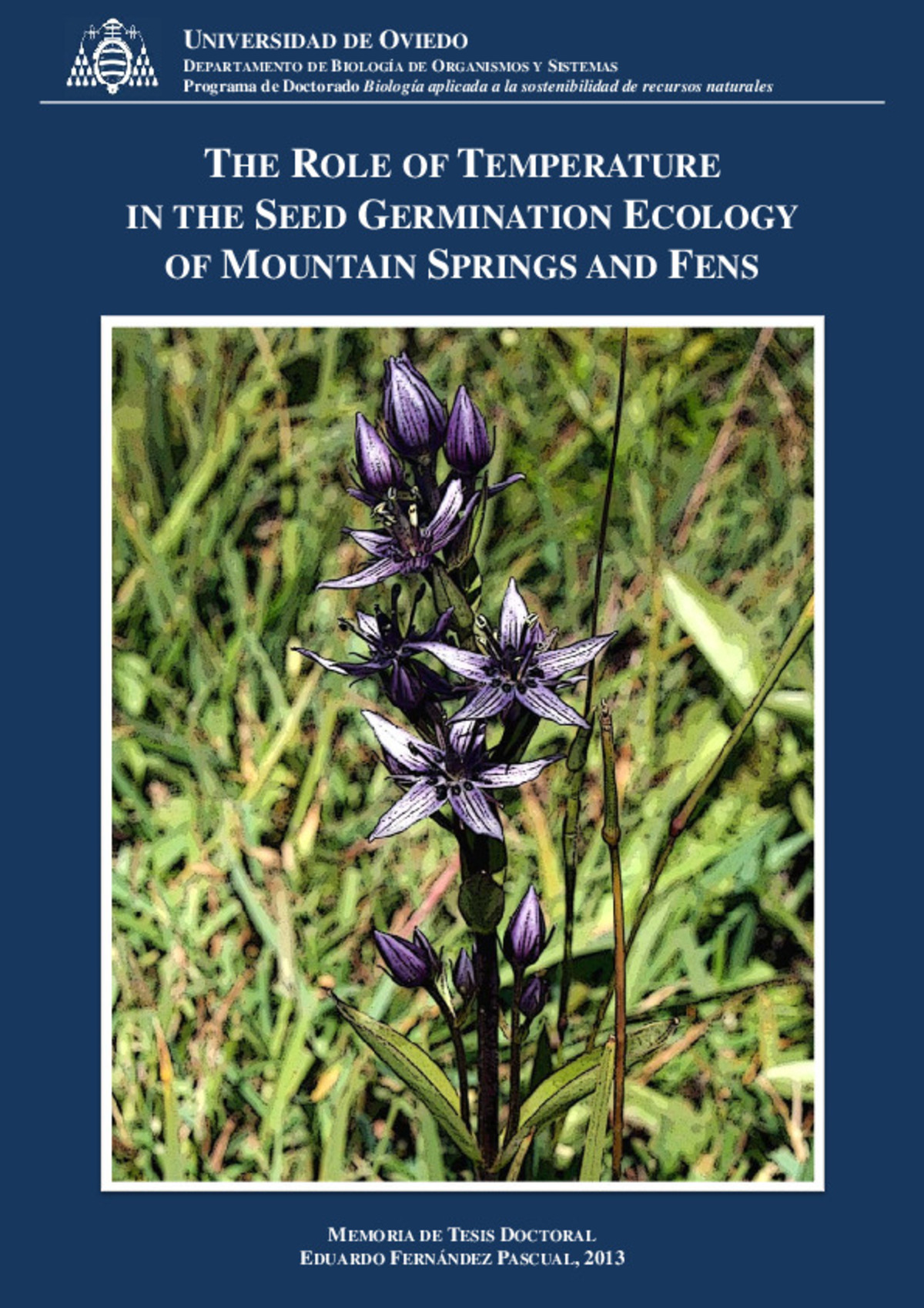The Role of Temperature in the Seed Germination Ecology of Mountain Springs and Fens
Otros títulos:
El papel de la temperatura en la ecología de la germinación de semillas de fuentes y tremedales de montaña
Autor(es) y otros:
Centro/Departamento/Otros:
Palabra(s) clave:
Plant Ecology
Seed Biology
Fecha de publicación:
Resumen:
Mountain calcareous spring fens are floristically diverse wetlands fed by carbonate-rich groundwater. This thesis studies their seed ecology, focusing on the interaction between environmental temperature and germination. To this end we conduct laboratory germination experiments with calcareous spring fen species to characterize the temperature dimension of the germination niche and identify specific germination strategies. We explore the special thermal characteristics of fen soils and their consequences on germination. Using the Cantabrian endemic Centaurium somedanum as a study species, we investigate the germination ecology of spring specialists and perform a common garden experiment supported by ISSR fingerprinting to determine the genetic and environmental influences on seed dormancy variation. Based on our results, we propose two germination strategies. Fen species generally follow a warm strategy, characterized by a heat response capable of overriding dormancy during episodes of unusual heat. Spring species lack the heat response and germinate only at cool temperatures. Fen soils have a buffer effect that makes their temperature less extreme than predicted, especially during the night and in winter. However, the germination niche breadth of fen species shows plasticity and is narrower in regions with harsher winters. The germination ecology of the spring specialist C. somedanum departs from the general germination patterns of its genus, showing morphophysiological dormancy and cool germination. This species has a local dormancy cline that is related to the genetic composition of the populations and to site climate, but that also responds in the short term to the seed maturation environment. These results highlight the potential of germination traits to react to climate changes at different spatial and temporal scales.
Mountain calcareous spring fens are floristically diverse wetlands fed by carbonate-rich groundwater. This thesis studies their seed ecology, focusing on the interaction between environmental temperature and germination. To this end we conduct laboratory germination experiments with calcareous spring fen species to characterize the temperature dimension of the germination niche and identify specific germination strategies. We explore the special thermal characteristics of fen soils and their consequences on germination. Using the Cantabrian endemic Centaurium somedanum as a study species, we investigate the germination ecology of spring specialists and perform a common garden experiment supported by ISSR fingerprinting to determine the genetic and environmental influences on seed dormancy variation. Based on our results, we propose two germination strategies. Fen species generally follow a warm strategy, characterized by a heat response capable of overriding dormancy during episodes of unusual heat. Spring species lack the heat response and germinate only at cool temperatures. Fen soils have a buffer effect that makes their temperature less extreme than predicted, especially during the night and in winter. However, the germination niche breadth of fen species shows plasticity and is narrower in regions with harsher winters. The germination ecology of the spring specialist C. somedanum departs from the general germination patterns of its genus, showing morphophysiological dormancy and cool germination. This species has a local dormancy cline that is related to the genetic composition of the populations and to site climate, but that also responds in the short term to the seed maturation environment. These results highlight the potential of germination traits to react to climate changes at different spatial and temporal scales.
Descripción:
Tesis doctoral por el sistema de Compendio de Publicaciones
Notas Locales:
DT(SE) 2013-135
Patrocinado por:
Ayuda BP09107; Programa de Ayudas Predoctorales “Severo Ochoa”; Plan de Ciencia, Tecnología e Innovación del Principado de Asturias; Consejería de Educación y Ciencia; Gobierno del Principado de Asturias. Ayudas económicas para la realización de estancias en el extranjero durante el año 2012 a los beneficiarios de ayudas predoctorales del programa “Severo Ochoa”; Convenio entre la Administración del Principado de Asturias y la Universidad de Oviedo, para el Desarrollo del Plan Estratégico de Viabilidad y Conversión a Campus de Excelencia Internacional; Consejería de Educación y Ciencia; Gobierno del Principado de Asturias. Proyecto “Conservación ex situ de plantas amenazadas de máxima prioridad en el norte peninsular: Aster pyrenaeus y Centaurium somedanum”; Fundación Biodiversidad; Ministerio de Medio Ambiente, y Medio Rural y Marino; Gobierno de España.
Colecciones
- Tesis [7669]
- Tesis doctorales a texto completo [2164]
Ficheros en el ítem





